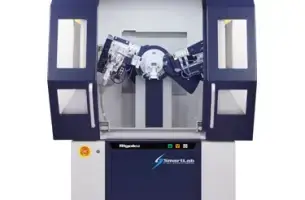Image

Specifications
- Model: Rigaku SmartLab
- PhotonMax high-flux 9 kW rotating anode X-ray source, in-plane arm (5-axis goniometer).
- Voltage: 20 - 45 kV, Current: 10 - 200 mA.
- Detectors: HyPix 3000.
- Goniometer System: Measuring range: -3 -- 160° (2θ). Scanning speed: 0.01° - 50° (θs, θd). Slewing speed: max. 250°/min (θs, θd). Step Resolution: 0.0001°(θs, θd).
- Software: PDXL Qualitative Academic, 3D Explore PF (Pole figure), Data Mapper Academic, QA-Tex Academic.
Principles
X-ray diffraction techniques are used for the identification of crystalline phases of various materials and the quantitative phase analysis subsequent to the identification. X-ray diffraction techniques are superior in elucidating the three-dimensional atomic structure of crystalline solids. The properties and functions of materials largely depend on the crystal structures. X-ray diffraction techniques have, therefore, been widely used as an indispensable means in materials research, development, and production.
Capabilities
- Automated multipurpose x-ray diffractometer (XRD) with guidance software for Powder diffraction, thin film metrology, SAXS, in-plane scattering, operando measurements.
- Composition identification, Crystal orientation, In-plane diffraction, Microdiffraction, Polymorphs, Pore size distribution, Powder crystallography, Qualitative analysis, Quantitative analysis, Semiconductor metrology, Texture and pole figures and Thin film analysis.
Applications
- Academic research, Chemistry, Coatings, Materials science, Nanotechnology, Photovoltaic manufacturing, Semiconductor manufacturing, Pharmaceuticals, Advanced and new materials


 Colored
Colored Grayscale
Grayscale

